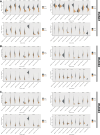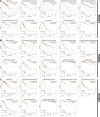RUNX transcription factors: biological functions and implications in cancer
- PMID: 38430423
- PMCID: PMC10908630
- DOI: 10.1007/s10238-023-01281-0
RUNX transcription factors: biological functions and implications in cancer
Abstract
Runt-related transcription factors (RUNX) are a family of transcription factors that are essential for normal and malignant hematopoietic processes. Their most widely recognized role in malignancy is to promote the occurrence and development of acute myeloid leukemia. However, it is worth noting that during the last decade, studies of RUNX proteins in solid tumors have made considerable progress, suggesting that these proteins are directly involved in different stages of tumor development, including tumor initiation, progression, and invasion. RUNX proteins also play a role in tumor angiogenesis, the maintenance of tumor cell stemness, and resistance to antitumor drugs. These findings have led to the consideration of RUNX as a tumor biomarker. All RUNX proteins are involved in the occurrence and development of solid tumors, but the role of each RUNX protein in different tumors and the major signaling pathways involved are complicated by tumor heterogeneity and the interacting tumor microenvironment. Understanding how the dysregulation of RUNX in tumors affects normal biological processes is important to elucidate the molecular mechanisms by which RUNX affects malignant tumors.
Keywords: Angiogenesis; Drug resistance; RUNX family; Signaling pathways; Tumor cell stemness; Tumor microenvironment.
© 2024. The Author(s).
Conflict of interest statement
The authors have no relevant financial or non-financial interests to disclose.
Figures



References
-
- Chuang LS, Ito K, Ito Y. RUNX family: regulation and diversification of roles through interacting proteins. Int J Cancer. 2013;132(6):1260–71. - PubMed
-
- Durst KL, Hiebert SW. Role of RUNX family members in transcriptional repression and gene silencing. Oncogene. 2004;23(24):4220–4. - PubMed
-
- Martinez-Soria N, McKenzie L, Draper J, Ptasinska A, Issa H, Potluri S, Blair HJ, Pickin A, Isa A, Chin PS, Tirtakusuma R, Coleman D, Nakjang S, Assi S, Forster V, Reza M, Law E, Berry P, Mueller D, Osborne C, Elder A, Bomken SN, Pal D, Allan JM, Veal GJ, Cockerill PN, Wichmann C, Vormoor J, Lacaud G, Bonifer C, Heidenreich O. The oncogenic transcription factor RUNX1/ETO corrupts cell cycle regulation to drive leukemic transformation. Cancer Cell. 2018;34(4):626–42. - PMC - PubMed
Publication types
MeSH terms
Substances
Grants and funding
LinkOut - more resources
Full Text Sources
Medical

